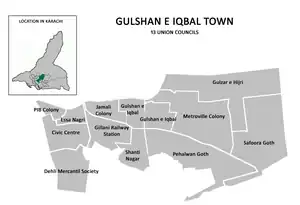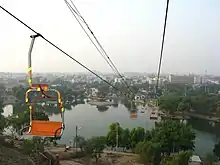Gulshan Town
Gulshan Town (Urdu: گلشن ٹاؤن) is a Karachi borough in the northeastern part of Karachi. Gulshan Town was formed in 2001 as part of the Local Government Ordinance 2001, and was subdivided into 11 union councils. The town system was disbanded in 2011, and Gulshan Town was reorganized as a subdivision of Karachi East District in 2015.[1][2]
Gulshan Town
گلشن اقبال ٹاؤن گلشن اقبال ٽاؤن | |
|---|---|
 Gulshan Town was divided into 13 Union Councils | |
| Country | Pakistan |
| Province | Sindh |
| City District | Karachi |
| Established | 14 August 2001 |
| Disbanded | 2011 |
| Union Councils | 13: Civic Centre, Delhi Mercantile Society, Essa Nagri, Gillani Railway Station, Gulshan-e-Iqbal I, Gulshan-e-Iqbal II, Gulzar-e-Hijri, Jamali Colony, Metroville Colony, Pehlwan Goth, P.I.B. Colony, Safooran Goth, Shanti Nagar |
| Government | |
| • Type | Town Council |
| • Town Chairman | Dr Fauad Ahmed |
| • vice chairman | Muhammad Ibrahim Siddiqui |
| Population (1998) | |
| • Total | 646,662 |
| Area code | Vehicle No s-4215 |
| Office Location | Plot#14, Scheme 24, Adjacent Civic Center, University Road Karachi |
| Contact | (021) 99230355-9 & (021) 99231363 |
Gulshan-e-Iqbal restored as Town in January 2022.[3]
Location
Gulshan Town is bordered by Gadap Town to the north, the Faisal and Malir Cantonments to the east, Jamshed Town to the southwest, and Gulberg and Liaquatabad to the west.
History
The federal government under Pervez Musharraf, who seized power in a 1999 coup d'etat, introduced local government reforms in the year 2000, which eliminated the previous "third tier of government" (administrative divisions) and replaced it with the fourth tier (districts). The effect in Karachi was the dissolution of the former Karachi Division in 2001, and the merging of its five districts to form a new Karachi City-District with eighteen autonomous constituent towns including Gulshan Town. In 2011, the system was disbanded but remained in place for bureaucratic administration until 2015, when the Karachi Metropolitan Corporation system was reintroduced. In 2015, Gulshan Town was re-organized as a sub-division as part of Karachi East district.
Gulshan-e-Iqbal town was restored as a Town in January 2022, which includes union committees 20, 21, 22, 23, 24, 25, 26 & 28.[3]
Commissioner of Karachi (Syed Darbar Ali Shah) envisioned setting up a new town Gulshan-e-Iqbal on 16 April 1966. It was originally Karachi Development Authority (scheme 24) which was renamed in the name of Pakistan's national poet Allama Muhammad Iqbal. Gulshan Town saw a lot of development after setting up of Civic Centre, Karachi and Karachi Expo Center.
Demographics
The population of Gulshan Town was estimated to be about 650,000 at the 1998 census, of which 99.5% are Muslim. It is dominated by the Urdu-speaking Muhajirs.[4][5] The minorities include, Sindhis, Punjabis, Kashmiris, Saraikis, Pakhtuns, Balochis, etc. The population of Gulshan Town was estimated to be nearly one million before census 2017. A small number of Konkani Muslims are also settled in the Kokan Cooperative Housing Society of Gulshan-e-Iqbal Town.
Neighbourhoods

Gulshan Town is the location of the main University of Karachi campus, as well as the offices of the City District Government of Karachi and the Attorney General of Sindh province. There are also few large parks which includes Aziz Bhatti Park, Askari Park, Aladin Park (now Bagh-e-Karachi) and the Safari Park.
- Delhi Mercantile Society[1]
- Essa Nagri
- Bahadurabad
- Hyderabad Colony
- Gulshan-e-Iqbal I[1]
- Gulshan-e-Iqbal II[1]
- Gulzar-e-Hijri
- Gulistan-e-Johar[1]
- Abbas Town
- Kokan Cooperative Housing Society
- Jamali Colony
- Metroville Colony
- Pehlwan Goth
- P.I.B. Colony[1]
- Safoora Goth
- Shanti Nagar[1]
- Sachal Goth
- KESC Society
Education
Gulshan-e-Iqbal area may be called as a university town having more than a dozen of higher education institutions. Few of the major institutions are as follows:
- University of Karachi
- NED University of Engineering and Technology
- Institute of Business Administration, Karachi
- SSUET
- Federal Urdu University
- UIT University
- Aga Khan University
- Liaquat University of Medical & Health Sciences
- Indus University
- Karachi School of Arts
- Iqra University
and several others
See also
- Zeenatabad Society
- Sharfabad Society
- Bahadurabad
- City District Government
- Karachi
- Lahore
References
- "Gulshan Town, Karachi". City Government of Karachi website. Archived from the original on 13 June 2006. Retrieved 1 June 2022.
- KARACHI: Rs1,085m budget for Gulshan Town Dawn (newspaper), Published 27 June 2006, Retrieved 1 June 2022
- Siddiqui, Tahir (8 January 2022). "Division of Karachi into 26 towns, 233 UCs notified". Dawn (newspaper). Retrieved 1 June 2022.
- Rizvi, Sakina (December 2018). "Micro Thesis: The Muhajir Identity and Effect of Ethnic Discrimination on the Urban Development of Karachi". ResearchGate. Retrieved 20 November 2022.
- Sardar, Ziauddin; Yassin-Kassab, Robin (2012). Pakistan?. Oxford University Press. ISBN 978-1-84904-223-9.
If we go to Gulshan or Nazimabad (Muhajir neighbourhoods) and we see all of the schools and the businesses and the clean roads, we realise, where are we living? But just as Muttahida [the MQM] did it for themselves, it's for us to worry